I’ve chosen as my first book review the first serious riding book I ever owned. A gift from a friend around the time I got my first horse, I have read and reread it many times over the decades. I’ve also loaned it to my students many times over the years, not always getting it back. As a result, I am on my third and (more recently) fourth copy (more on that later).
The book, originally published in German in 1933, is a timeless reference for the person who wants solid broad knowledge of quality riding and training. The author, Wilhelm Museler, was a cavalry man in the early years of the 20th century. In the years leading up to World War I, he competed successfully in Dressage and Show Jumping. After the war ended, he became the director of the largest equestrian center in Berlin. Museler believed the following:
The rider should practise regularly the following three things:
Riding in the school.
Riding across country.
Jumping.A Rider who belittles or neglects any one of these three will never fully master his horse.
Author’s Preface, pg x, 1973 edition

As a result of this philosophy, this book is not an in-depth classical Dressage work – except in so far as you believe that Dressage is defined as the training of the horse. He does go into the Haute Ecole movements, in terms of describing them – but he is very clear that this work is not meant as a detailed training reference for advanced riding.
Where this book excels is in a thorough description of what it takes to make a successful horse/rider team. The book begins with what it takes to train a successful rider. I found myself returning to the many drawings time and again to help explain position to my riding students. One cautionary note is that the book refers to “bracing the back” many times as a critical part of the rider’s position and function. This may be a flaw in translation, as the original phrase “das Kreuz anzichen” apparently has no clear English translatable equivalent, according to F.W. Schiller, the translator for the 1937 publication in English. What he describes is not a hard, stiff, or overly strong action as can too often be seen in modern riders who are told to “brace the back”.
The reader must pay close attention, with no pre-concieved ideas about that term, in order to understand what the author means. They key element to correctly bracing the back is an independent seat that can operate separate from the arms, and therefore the contact. As you read the book you will find that bracing the back comes into use in many of the author’s descriptions of riding, some of which require a release of contact, rather than the too common over-strong increase in contact.

The horse is very good natured, very friendly towards man, and much more sensitive than is generally assumed. He is very receptive to patting and fondling, and besides possessing a marvellous memory, has an exceedingly well-developed sense of locality. He very quickly acquires habits and firmly sticks to them.
Chapter Two, The Schooling of the Horse, 1973 Edition
One thing made clear throughout the book is that the author has affection for the horse, and puts any problems with its training pretty squarely with the rider. The writing is candid, calling out typical flaws seen in riding, but also pointing out why some riders may find flawed riding more comfortable. For example, when first discussing collection in the chapter on Schooling the Horse, he refers to horses who are taught a head set without actual collection. Although he acknowledges the flaw in this approach, he also has the following to say:
Inexperienced riders find such horses quite reasonable to ride both in the school and hacking out in the countryside with which the horse is familiar. The horses do not use themselves to any extent and their paces show little elevation. Their riders will therefore be thrown upwards relatively little and will find things quite comfortable.
Pg 102, 1983 Edition
He does go on to describe some control issues such riders might have, if they try to go outside of the horse’s comfort zone – so it is not an endorsement of this riding as something to strive for. He is accepting of the presence of lesser trained horses and riders, but clear about the level of performance one can expect under such conditions. He uses it as a baseline to then discuss what a horseman should strive for and achieve in their riding and training.
The book is filled with informative drawings and photos in support of the text. It is perhaps the most helpful aspect of the book. However, I recommend older versions of the book for the full experience. I recently purchased a copy of the 1973 edition, which was my original version, for comparison to the 1983 edition I already had, in which drawings were redone. A comparison of the two confirmed what I had suspected – that the changes to illustrations left much to be desired. For example, here are the illustrations on rein holds for the double bridle.
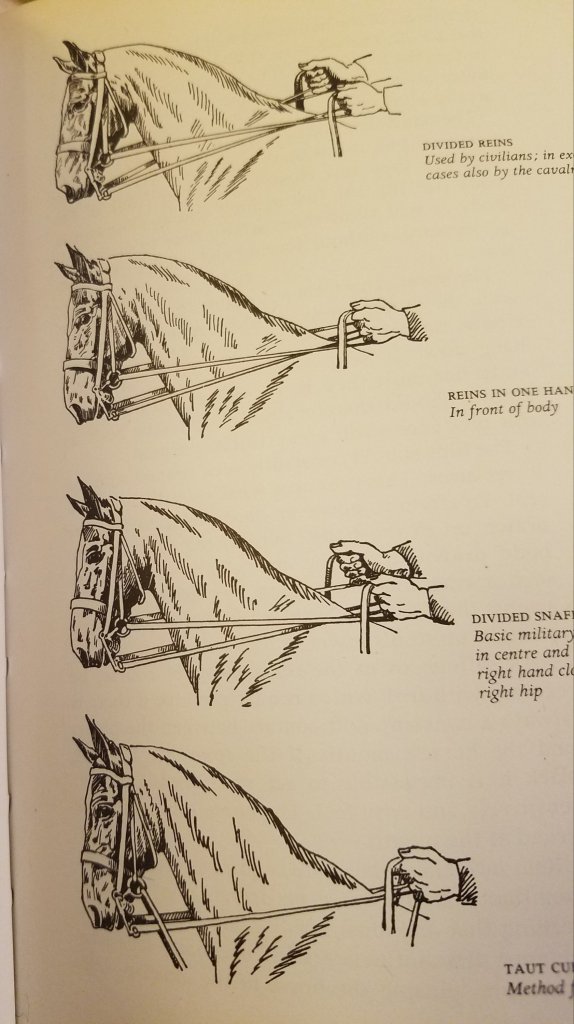
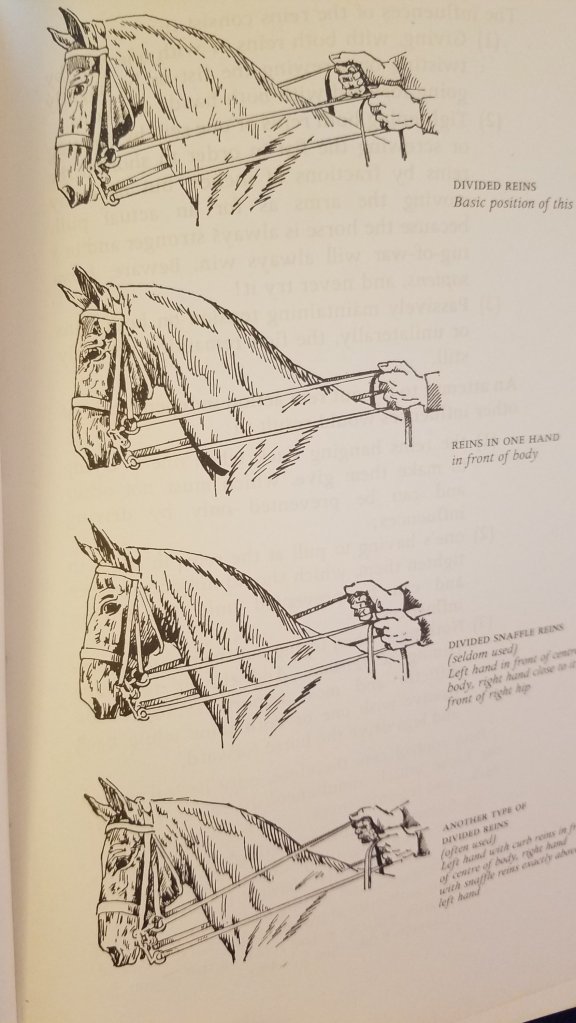
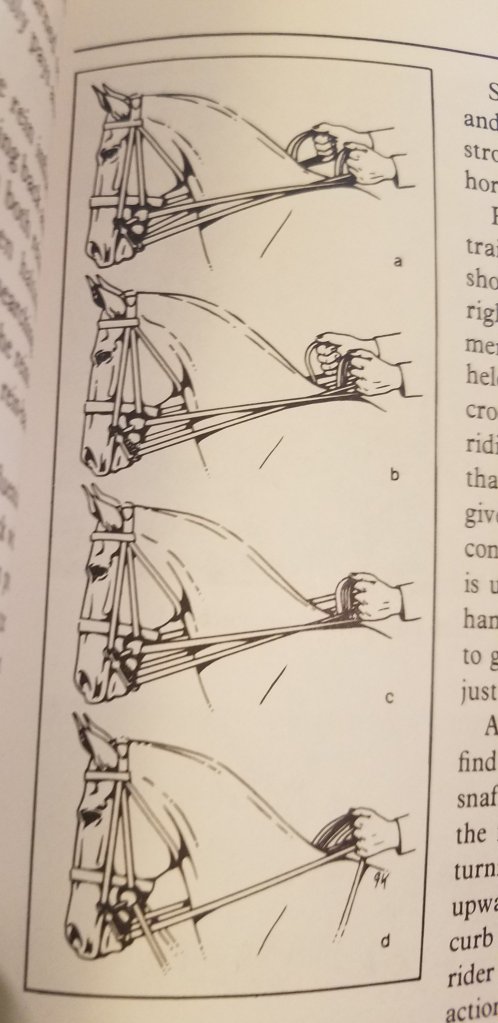
As you can see, the older edition has twice as much information. You may not need to know all eight rein holds – but it’s a much richer reference material with them. The same is true on the section about the canter, where the newer version has only three photos to illustrate different canters, while the older version has six. And each image in the older version truly is of a different type of canter, including full gallop.
But it is not just in the number of illustrations in which the older version is better – some of the older drawings are actually more accurate than in the new version. For example, look at these two different versions of collection and carriage, from basic to levade.
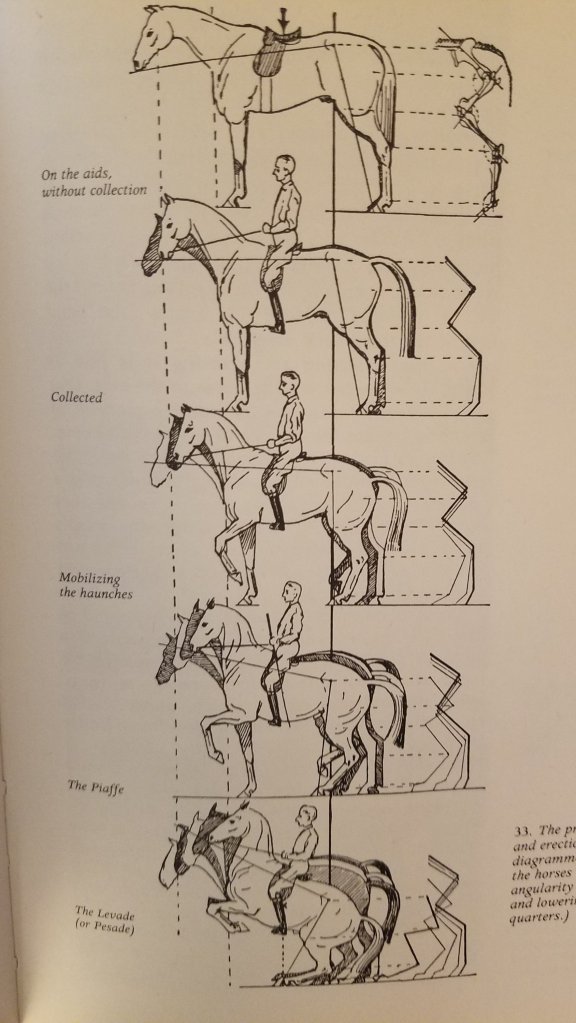
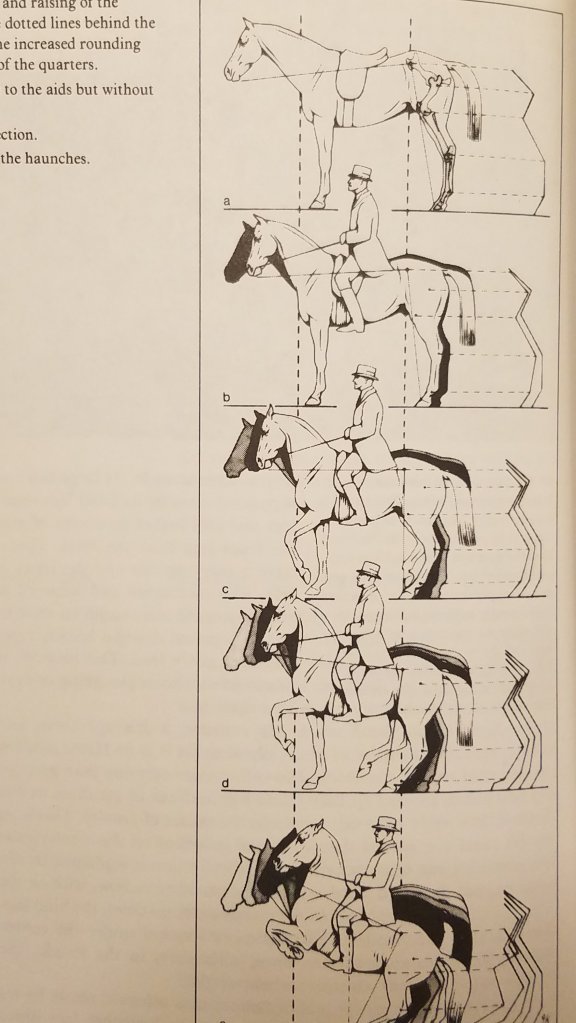
Notice how different the angles behind the horses are between the two versions. Those lines and angles represent the changes in the hind leg angles for the various levels of collection. Note, in particular, how much more shallow the later version represents the piaffe and levade angles. The angles in the older version are more classically correct, and therefore more true to the author’s intent. The version on the right has also removed the first vertical line, meant as a reference to the placement of the horse’s face, relative to the vertical. A minor omission, but still hewing away from the author’s intent.
After being out of print for over ten years, a new print of the book was released in 2007. I have not looked inside that version, but with the changes I see between my two versions, and changes I’ve seen in modern versions of other key works, I would fear that the illustrations skew even harder toward the dysfunction of modern competitive riding. From a quick internet search, that more modern version is selling for a much higher price than the vintage versions – so, another argument for getting an older copy. In particular I would recommend checking out the options at Abe Books, as they seem to have better pricing than others I found (it is where I found my 1973 edition).
This is one of the best books for providing an overview of English riding, from basic position to jumping and riding cross-country. It provides good illustrations that aid in understanding, including diagrams of the exercises used in developing the horse toward a more collected way of going. There are many other excellent texts out there, which I will gradually get reviewed on these pages – but few illustrate the points as well as this book.
I would recommend this book to anyone who is:
- Starting their equestrian library, or wants to expand it with solid material on equitation/horsemanship
- Trying to better their understanding of correct rider position and function
- Just starting to learn the different gaits and movements in Dressage
- Looking for exercises to improve their riding and their horse’s way of going
One final pitch for the older version – my 1973 edition has a lovely Translator’s Preface to start the book (omitted from the 1983 edition). Written by the original English language translator, it gives a history of how the book came to be translated into English. It was apparently at the urging of Lt-Col. M.F. McTaggart, a name well known in the history of British horsemanship. McTaggart was the driver behind the translation, but did not live to see it published. The preface has some wonderful things to say about McTaggart (for those interested in horsemanship history) as well as some perspective on the riding in England in that time, and some insight into the translation itself. I will leave this review of Riding Logic with this closing paragraph from the Translator’s Preface.
One more small piece of advice: be patient, fair reader! ‘Patience’ should be written across your stable door, across the four walls of your riding school, across the pommel of your saddle. Be patient in reading this book and still more so in applying its teachings. They are expressed in plain simple words. They may perhaps lack the mysterious ” ‘ossy” language, this cherished treasure of the initiated, but they will soon raise you from the condition of being carried about by a horse to HORSEMANSHIP and HORSEMASTERSHIP, and riding will be a pleasure instead of a ‘bally nuisance’.
London, January 1937, FW Schiller
Categories: Book Review

Your reviews are amazing. Thanks for posting!
LikeLiked by 1 person
Thank you, Emily! I’m glad you’re enjoying them!
LikeLike
Your review of “Riding Logic” is a captivating exploration of the intricacies of horse riding. The way you dissect and evaluate the book’s content reflects a keen understanding of the equestrian world. While your analysis touches upon various aspects, considering the potential applicability of techniques for managing a hot horse could further enrich your review. Exploring how the book addresses and provides insights into handling the challenges posed by spirited or energetic horses would be a valuable addition. Your review is already informative and engaging, and incorporating insights into managing a hot horse could enhance its practicality for a broader audience of riders.
LikeLike